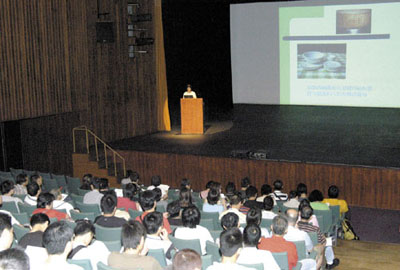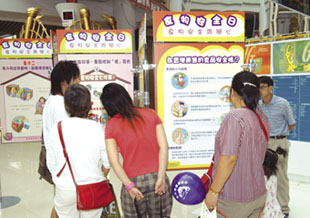
3rd Issue 2004
Food Safety Day
Food Safety is Everyone's Business
 Hi, everybody! As a young reporter, I always like trying various delicacies. I have full confidence in the food safety in Hong Kong. After visiting the "Food Safety Roadshow" held at Olympian City in Kowloon on 10 July (Saturday) as part of the activities of Food Safety Day, I realized that food safety cannot rely on the Government alone. A concerted effort of the food trade and the public is needed if we want to uphold the food safety standards. In this hot summer, the Food and Environmental Hygiene Department (FEHD) had organised a series of activities on food safety in Hong Kong. In order to bring first-hand information to the "gourmets", I would give a detailed report on the activities of Food Safety Day.
Hi, everybody! As a young reporter, I always like trying various delicacies. I have full confidence in the food safety in Hong Kong. After visiting the "Food Safety Roadshow" held at Olympian City in Kowloon on 10 July (Saturday) as part of the activities of Food Safety Day, I realized that food safety cannot rely on the Government alone. A concerted effort of the food trade and the public is needed if we want to uphold the food safety standards. In this hot summer, the Food and Environmental Hygiene Department (FEHD) had organised a series of activities on food safety in Hong Kong. In order to bring first-hand information to the "gourmets", I would give a detailed report on the activities of Food Safety Day.
Food Safety Day, with the theme of "Food Safety is Everyone's Business", was a major campaign featuring a host of activities organized by FEHD to promote the attention and active participation of the public and the food trade in maintaining food safety in Hong Kong. The "Food Safety Roadshow" on 10 July kicked off a series of programmes on hygiene education and publicity activities between July and November.
The "Food Safety Roadshow" at Olympian City in Kowloon comprised of variety shows, singing by artistes, booth games, hygiene education videos and exhibitions, etc. The purpose was to inculcate, at different levels, the message of food safety in the participants. The simple yet solemn opening ceremony was officiated by Mrs Carrie Yau, Permanent Secretary for Health, Welfare and Food, together with Mr Gregory Leung, Director of Food and Environmental Hygiene, Mr Philip Chow, Head of Chinese Programme Service of Radio Television Hong Kong, Mr Lee Kwong-lam, Vice-president of the Hong Kong Food Council and Ms Connie Lau, Deputy Chief Executive of the Consumer Council. The opening symbolized the tripartite efforts of the Government, the food trade and the public in promoting the message of "Food Safety is Everyone's Business".
The artistes played interesting and educational games such as "Funny Scores Shopping Bags", "Defrosting Q&A" and "Food Safety Tongue Twister" with the participants on the spot to test their knowledge of food safety. The games helped to remind the public and the food trade on important issues when purchasing food or handling raw, cooked or frozen food. The programmes were much welcome by the public and attracted many people at the venue.
As part of the Food Safety Day activities, FEHD would also organize other interesting programmes.

Co-organized by FEHD and RTHK, the "Food Safety Roadshow" held at Olympian City 2 on 10 July was officiated by Mrs Carrie YAU, Permanent Secretary for Health, Welfare and Food. Also officiating at the ceremony were Mr Gregory LEUNG, Director of Food and Environmental Hygiene (2nd right), Mr Philip CHOW, Head of Chinese Programme Service of RTHK (2nd left), Mr LEE Kwong-lam, Vice-president of the Hong Kong Food Council (right) and Ms Connie LAU, Deputy Chief Executive of the Consumer Council (left).

Food Safety Seminars in various districts (July - October)

Food Safety Roving Exhibitions in various districts (July - October)

Children participating in the computer games on the "Food Safety Day".
Public Opinion Survey on Labelling Scheme on Nutrition Information (LSNI)
In order to gauge the public's views on nutrition information of existing labels on pre-packaged foods and to collect public opinions on the implementation of the Labelling Scheme on Nutrition Information, the Government conducted an opinion survey at the beginning of 2004. The survey successfully contacted 1 200 people aged 18 or above over the telephone and the results were as follows:
Opinions towards the nutrition information of existing labels on pre-packaged foods

- About half (49.8%) of the respondents indicated that they usually read the nutrition information on the labels before purchasing pre-packaged food.
- Twenty-six percent (26.2%) of the respondents considered that the labels on most of the pre-packaged foods in Hong Kong presented the nutrient information clearly. About forty-eight percent (47.9%) thought that only a small number of the labels had done so.
Opinions towards the implementation of the Labelling Scheme on Nutrition Information
-
Opinions towards the LSNI in general
- About ninety-five percent (95.3%) of the respondents agreed that the Government should regulate nutrition label of pre-packaged foods.
- If all pre-packaged foods were labelled with nutrition information in the future, ninety-one percent (90.8%) of the respondents indicated that they would read such information. Among them, close to ninety percent (89.2%) indicated that they would use such information in making food choices, constituting eighty-one percent (81.0%) of all respondents.
- About eighty-five percent or more of the respondents agreed on the effectiveness of the LSNI. Among them, eighty-four percent (84.4%) agreed that the scheme could promote a balanced diet, more than ninety percent (90.5%) agreed that the scheme could enhance public health and ninety-six percent (96.1%) agreed that providing nutrition information on food labels would enable consumers to make healthy food choices.
-
Opinions towards the details of the scheme
- Ninety-five percent (94.5%) of the respondents supported standardization of the format of nutrition labels for easy reference of the public and to avoid confusion.
- Ninety-three percent (92.6%) of the respondents considered the proposal of the Government to list out the nutrition information relating to public health (including energy content and the nine core nutrients) on the labels of pre-packaged foods as appropriate.
- Ninety-five percent (94.9%) of the respondents considered the proposal of the Government to regulate nutrient content claims in accordance with international standards as appropriate. Furthermore, ninety percent (90.4%) of the respondents considered the proposal of the Government to regulate nutrient function claims in accordance with international standards as appropriate.
-
Opinions towards possible effects of the scheme
- While implementation of the LSNI can help to avoid chronic diseases and enhance public health, thereby cutting down the overall health care costs of society, it might also lead to a slight increase in prices of some food items. After weighing out the two factors, eighty-nine percent (89.4%) of the respondents supported the implementation of the LSNI, while six percent (6.0%) did not.
- Even though implementation of a mandatory LSNI would hinder the importation of some food items to Hong Kong, leading to a reduction of the varieties of food items on the market, eighty-one percent (81.1%) of the respondents still indicated that they would support the implementation of the LSNI, while eleven percent (11.3%) indicated otherwise
As shown in the above results, most people recognised the importance of the nutrition label, and supported the Government's introduction of the LSNI. Before finalising the details and implementing the LSNI, the Government would assess the impact of the proposed regulatory measures in order to estimate the scheme's cost-effectiveness and draw up a package of measures most suitable for our local situation.
How to Ensure Safe Consumption of Barbecued Meat
Barbecued meat is defined as meat product prepared by a dry heat cooking methods such as grilling and roasting. Two types of barbecued meat, namely jerky and Cantonese-style barbecued meat, popularly known as siu mei, are very popular in Hong Kong.
A number of studies conducted in recent years show that cancer-causing compounds, polycyclic aromatic hydrocarbons (PAHs)1 , can be produced if barbecued meat is not processed properly. It is because fat dripping from the meat onto the heat source during the barbecuing process produces PAHs which will contaminate the meat surface, and incomplete combustion of cooking fuel (such as charcoal or wood) may also generate PAHs. Factors contributing to the increase in PAH content of barbecued food include:
- Food being too close to heat source;
- High fat content of food;
- High temperature employed;
- Extended cooking period;
- Excessive fat dripping; and
- Type of fuel (such as charcoal or wood) used for cooking.
On the other hand, the Food & Environmental Hygiene Department has recently conducted a study on barbecued meat in Hong Kong. The findings of the study show that:
- Charcoal grilling produces the highest PAHs levels as compared with gas grilling or electric oven roasting.
- Higher levels of PAHs would be formed if food is barbecued at a higher temperature or at a closer distance from the heat source.
- PAHs were found mainly on the surface of barbecued meat.
As most siu mei offered for sale in the market are prepared by gas grilling or electric oven roasting, consumption of such food should, generally speaking, not increase the risk of intaking PAHs.
(For details, please visit our web page at http://www.fehd.gov.hk/english/pestcontrol/report/pah/index.html)
To enhance food safety, food manufacturers should take the following into consideration when manufacturing barbecued meat --
Selection of Cooking Methods and Temperature
- Gas grilling or electric oven roasting is preferred instead of charcoal grilling.
- Use a lower temperature to achieve the barbecuing effect.
Preparations before Barbecuing Meat
- Before and after barbecuing meat, clean the barbecuing utensils (such as the grilling racks, trays and hooks) thoroughly to prevent contamination of food by charred material on the utensils.
- Defrost frozen meat thoroughly to prevent under-cook of the centre portion of the meat.
- Choose lean meat and avoid fatty meat.
- Trim the visible fat and skin from meat to avoid fat dripping onto the heat source.
- Pre-cook meat by microwave oven or boiling to reduce the barbecuing time.
When Barbecuing
- When barbecuing meat, do not place the meat immediately above the heat source to avoid direct contact with and fat dripping onto the heat source.
- Do not start barbecuing until the heat source has reached a suitable temperature in order to reduce the barbecuing time.
- Install a "drip tray" in the heating chamber to avoid fat dripping onto the heat source.
- Avoid fat dripping onto the heat source even if a "drip tray" is not available.
- Meat should be thoroughly cooked until the core temperature reaches 75oC or above.
- Avoid charring the food.
- Remove charred portions before selling or serving the food.

1 PAHs refer to a large group of organic chemicals containing rings of carbon and hydrogen atoms. Over 100 kinds of PAHs can be found in air, soil, water and foods and are present as pollutants in the environment.
Food and Drugs (Composition and Labelling) (Amendment) Regulation
The Food and Drugs (Composition and Labelling) (Amendment) Regulation 2004 was published in the Gazette in May this year by the Food and Environmental Hygiene Department (FEHD) for the purpose of amending the Food and Drugs (Composition and Labelling) Regulations. Under the amended regulations, food manufacturers are required to declare, on the food labels, (1) both the (functional) class, the exact name or international code of the food additive used; and (2) the presence of eight types of substances which are known allergens for easy identification by the public. These substances are:
- cereals containing gluten
- crustacean and crustacean products
- eggs and egg products
- fish and fish products
- peanuts, soybeans and their products
- milk and milk products
- tree nuts and nut products
- sulphite in concentrations of 10 parts per million or more.

The amended legislation came into effect on July 9 this year. To allow the trade sufficient time to update the labels of pre-packaged foods in accordance with the said amendment, a grace period of 36 months has been granted.
Certain requirements were also relaxed under the new legislation. For example, the restriction on the marking sequence of the year, the month and the day of "best before" or "use by" date would be lifted provided that the exact sequence is clearly declared in both Chinese and English. The restriction of additives used in condensed milk, evaporated milk and butter would also be relaxed in accordance with the CODEX standards. Drinks with alcoholic strength by volume of more than 1.2 per cent but less than 10 per cent would continue to be exempted from the requirement of ingredients labelling. In addition, most of the drinks with an alcoholic strength of more than 10 per cent, such as wines and fruit wines, would also be exempted from the requirement of ingredient labelling and durability period.
Wash Hands Properly
For details, please visit our web page at http://www.fehd.gov.hk/english/pestcontrol/library/handwash/2.html